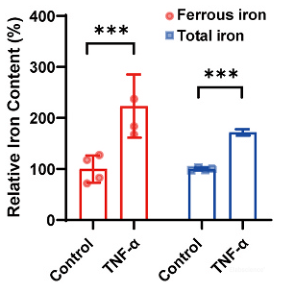Cell Ferrous Iron Colorimetric Assay Kit
SKU: E-BC-K881-M-96
Cell Ferrous Iron Colorimetric Assay Kit
| SKU # | E-BC-K881-M |
| Detection Instrument | Microplate reader (590-600 nm, optimum wavelength: 593 nm) |
|
Detection method |
Colorimetric method |
Product Details
Properties
| Sample type | Cells |
| Sensitivity | 0.4 μmol/L |
| Detection range | 0.4-50 μmol/L |
| Detection method | Colorimetric method |
| Assay type | Quantitative |
| Assay time | 40 min |
| Precision | Average inter-assay CV: 1.500% | Average intra-assay CV: 1.300% |
| Storage | 2-8℃ |
| Valid period | 12 months |
Images
Y Zhang et al investigate the ferroptosis of renal tubular epithelial cells that promoting chronic renal allograft interstitial fibrosis. Cell ferrous ion level in HK-2 cell were determined using cell ferrous ion colorimetric assay kit (E-BC-K881-M).

Intracellular ferrous iron was significantly increased in cells treated with TNF-α. (***P<0.0001)
Dilution of Sample
The recommended dilution factor for different samples is as follows (for reference only):
| Sample type | Dilution factor |
| HepG2 Cell | 1 |
| molt-4 Cell | 1 |
| Jurkat Cell | 1 |
| HEL Cell | 1 |
Detection Principle
Iron is one of the metal elements in organism and has important physiological functions. Ferrous ion is a key element in heme and hemoglobin and plays an important role in many biochemical reactions. Ferrous ions (Fe2+) in samples can bind with probe to form complexes, which has a maximum absorption peak at 593 nm. The concentration of ferrous ions can be calculated by measuring the OD value at 593 nm indirectly.
Kit Components & Storage
| Item | Component | Size 1(48 T) | Size 2(96 T) | Storage |
| Reagent 1 | Buffer Solution | 45 mL × 1 vial | 35 mL × 2 vials | 2-8℃, 12 month shading light |
| Reagent 2 | Control Solution | 5 mL × 1 vial | 10 mL × 1 vial | 2-8℃, 12 month shading light |
| Reagent 3 | Chromogenic Solution | 5 mL × 1 vial | 10 mL × 1 vial | 2-8℃, 12 month shading light |
| Reagent 4 | 10 mmol/L Iron Standard | 2 mL ×1 vial | 2 mL ×1 vial | 2-8℃, 12 month shading light |
| Reagent 5 | Standard Protectant | Powder × 1 vial | Powder × 1 vial | 2-8℃, 12 month shading light |
| Microplate | 96 wells | No requirement | ||
| Plate Sealer | 2 pieces | |||
Note: The reagents must be stored strictly according to the preservation conditions in the above table. The reagents in different kits cannot be mixed with each other. For a small volume of reagents, please centrifuge before use, so as not to obtain sufficient amount of reagents.
Technical Data:
Parameter:
Intra-assay Precision
Three HepG2 cell samples were assayed in replicates of 20 to determine precision within an assay (CV = Coefficient of Variation).
| Parameters | Sample 1 | Sample 2 | Sample 3 |
| Mean (μmol/L) | 2.80 | 162.00 | 46.00 |
| %CV | 1.5 | 1.3 | 1.1 |
Inter-assay Precision
Three HepG2 cell samples were assayed 20 times in duplicate by three operators to determine precision between assays.
| Parameters | Sample 1 | Sample 2 | Sample 3 |
| Mean (μmol/L) | 2.80 | 162.00 | 46.00 |
| %CV | 1.2 | 1.6 | 1.7 |
Recovery
Take three samples of high concentration, middle concentration and low concentration to test the samples of each concentration for 6 times parallelly to get the average recovery rate of 99%.
| Standard 1 | Standard 2 | Standard 3 | |
| Expected Conc. (μmol/L) | 6.8 | 17.5 | 36.5 |
| Observed Conc. (μmol/L) | 6.9 | 17.2 | 35.4 |
| Recovery rate(%) | 102 | 98 | 97 |
Sensitivity
The analytical sensitivity of the assay is 0.4 μmol/L. This was determined by adding two standard deviations to the mean O.D. obtained when the zero standard was assayed 20 times, and calculating the corresponding concentration.
Standard Curve
As the OD value of the standard curve may vary according to the conditions of the actual assay performance (e.g. operator, pipetting technique or temperature effects), so the standard curve and data are provided as below for reference only:
| Concentration (μmol/L) | 0 | 5 | 10 | 15 | 20 | 30 | 40 | 50 |
| Average OD | 0.045 | 0.079 | 0.110 | 0.136 | 0.163 | 0.221 | 0.288 | 0.352 |
| Absoluted OD | 0.000 | 0.035 | 0.065 | 0.091 | 0.118 | 0.177 | 0.244 | 0.307 |



